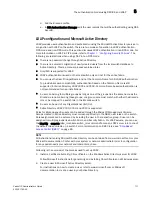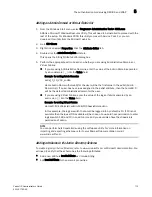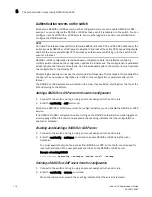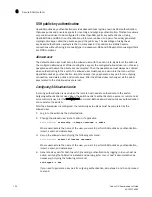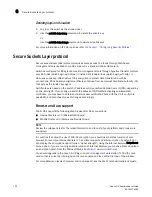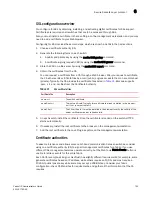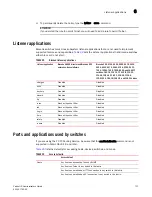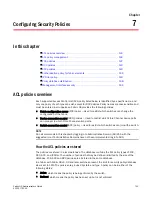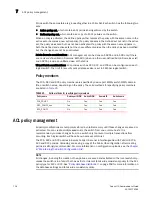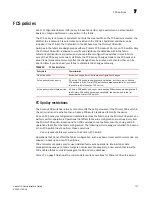
122
Fabric OS Administrator’s Guide
53-1001763-02
Secure Sockets Layer protocol
6
Deleting keys on the switch
1. Log in to the switch as the allowed-user.
2. Use the sshUtil delprivkey command to delete the private key.
or
Use the sshUtil delpubkeys command to delete all public keys.
For more information on IP Filter policies, refer to
Chapter 7, “Configuring Security Policies”
.
Secure Sockets Layer protocol
Secure sockets layer (SSL) protocol provides secure access to a fabric through Web-based
management tools like Web Tools. SSL support is a standard Fabric OS feature.
Switches configured for SSL grant access to management tools through hypertext transfer protocol
over SSL links (which begin with
https://
) instead of standard links (which begin with
http://
).
SSL uses public key infrastructure (PKI) encryption to protect data transferred over SSL
connections. PKI is based on digital certificates obtained from an Internet Certificate Authority (CA)
that acts as the trusted key agent.
Certificates are based on the switch IP address or fully qualified domain name (FQDN), depending
on the issuing CA. If you change a switch IP address or FQDN after activating an associated
certificate, you may have to obtain and install a new certificate. Check with the CA to verify this
possibility, and plan these types of changes accordingly.
Browser and Java support
Fabric OS supports the following Web browsers for SSL connections:
•
Internet Explorer v7.0 (Microsoft Windows)
•
Mozilla Firefox v2.0 (Solaris and Red Hat Linux)
NOTE
Review the release notes for the latest information and to verify if your platform and browser are
supported.
In countries that allow the use of 128-bit encryption, you should use the latest version of your
browser. For example, Internet Explorer 7.0 and later supports 128-bit encryption by default. You
can display the encryption support (called “cipher strength”) using the Internet Explorer Help:About
menu option. If you are running an earlier version of Internet Explorer, you may be able to download
an encryption patch from the Microsoft Web site at
http://www.microsoft.com
.
You should upgrade to the Java 1.6.0 Plug-in on your management workstation. To find the Java
version that is currently running, open the Java console and look at the first line of the window.
For more details on levels of browser and Java support, see the
Web Tools Administrator’s Guide
.
Summary of Contents for 53-1001763-02
Page 1: ...53 1001763 02 13 September 2010 Fabric OS Administrator s Guide Supporting Fabric OS v6 4 0 ...
Page 4: ...iv Fabric OS Administrator s Guide 53 1001763 02 ...
Page 24: ...xxiv Fabric OS Administrator s Guide 53 1001763 02 ...
Page 28: ...xxviii Fabric OS Administrator s Guide 53 1001763 02 ...
Page 32: ...xxxii Fabric OS Administrator s Guide 53 1001763 02 ...
Page 40: ...xl Fabric OS Administrator s Guide 53 1001763 02 ...
Page 42: ...2 Fabric OS Administrator s Guide 53 1001763 02 ...
Page 54: ...14 Fabric OS Administrator s Guide 53 1001763 02 High availability of daemon processes 1 ...
Page 74: ...34 Fabric OS Administrator s Guide 53 1001763 02 Basic connections 2 ...
Page 102: ...62 Fabric OS Administrator s Guide 53 1001763 02 Audit log configuration 3 ...
Page 214: ...174 Fabric OS Administrator s Guide 53 1001763 02 Management interface security 7 ...
Page 228: ...188 Fabric OS Administrator s Guide 53 1001763 02 Brocade configuration form 8 ...
Page 276: ...236 Fabric OS Administrator s Guide 53 1001763 02 Creating a logical fabric using XISLs 10 ...
Page 404: ...364 Fabric OS Administrator s Guide 53 1001763 02 ...
Page 440: ...400 Fabric OS Administrator s Guide 53 1001763 02 Performance data collection 17 ...
Page 480: ...440 Fabric OS Administrator s Guide 53 1001763 02 F_Port masterless trunking 19 ...
Page 494: ...454 Fabric OS Administrator s Guide 53 1001763 02 Buffer credit recovery 20 ...
Page 574: ...534 Fabric OS Administrator s Guide 53 1001763 02 Hexadecimal overview E ...




